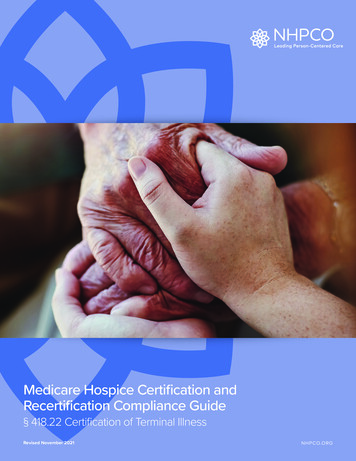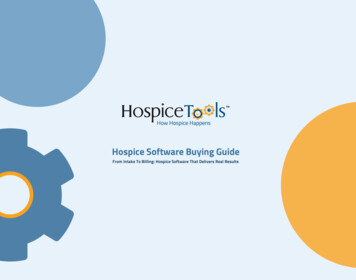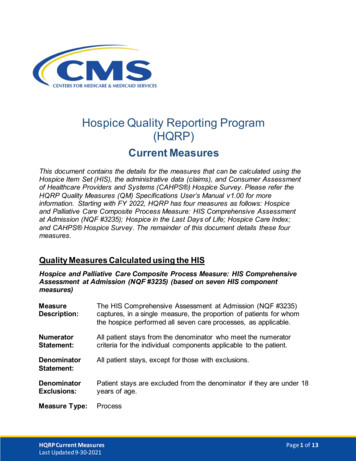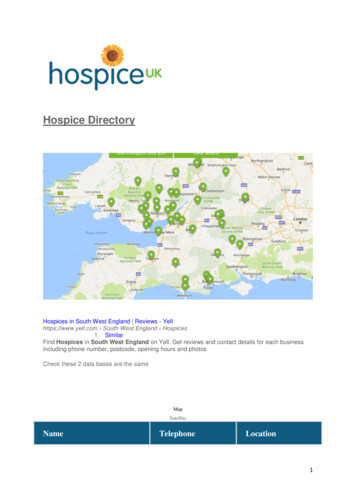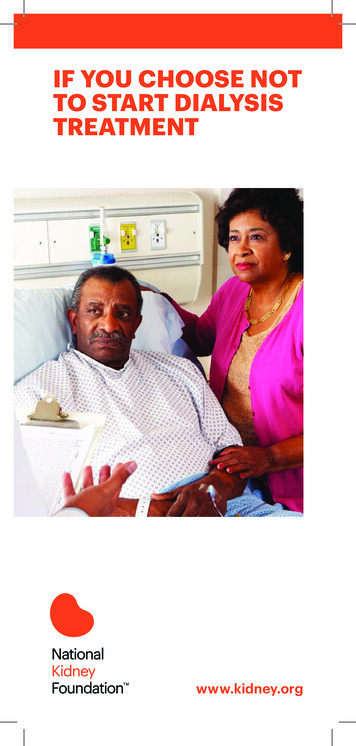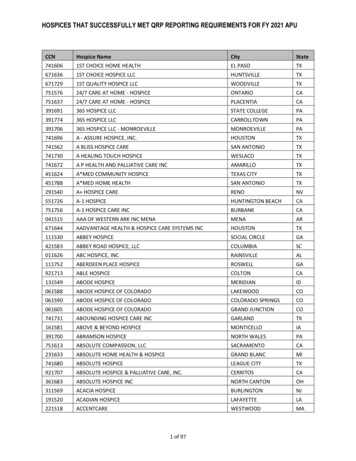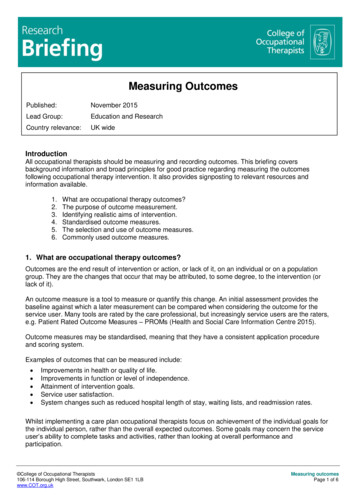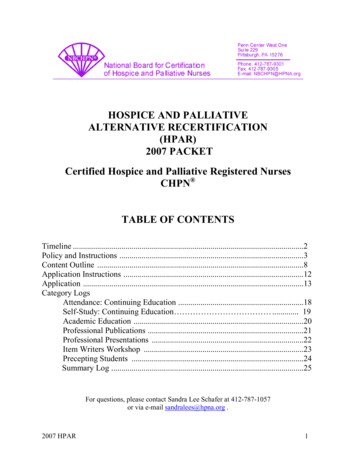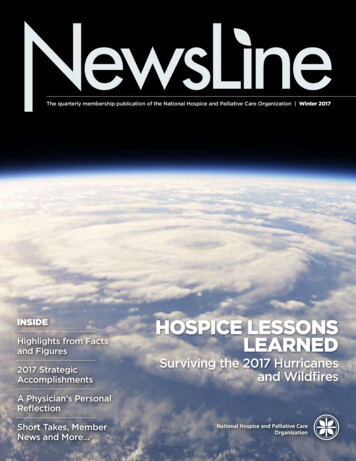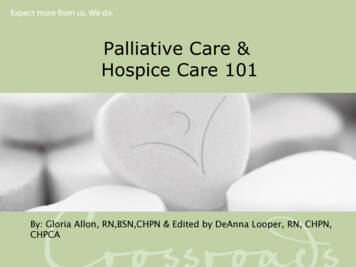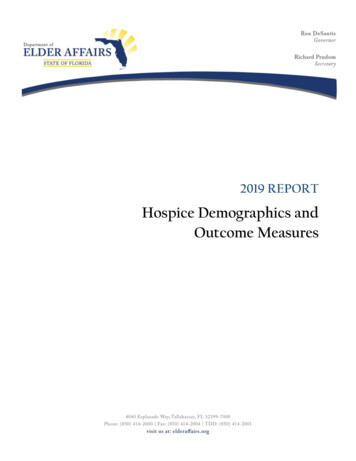
Transcription
2019 REPORTHospice Demographics andOutcome Measures
i2019 Hospice Demographic and Outcome Measures ReportNovember, 2019
Table of ContentsExecutive Summary . 4Data Collected . 5Individual Hospice Information . 6Accreditation . 6Hospice Geographical Coverage . 9Inpatient Facilities and Residential Units. 9Primary Diagnosis at Time of Admission . 12Patient Race and Ethnicity . 14Patient Age .15Discharges by Disposition Type .15Patient Days by Location .16Reimbursement . 17Outcome Measure 1 .18Outcome Measure 2 . 20Outcome Measure 2A . 20Additional Florida Hospice Data . 20Centers for Medicare & Medicaid Services (CMS) Quality Measures for Hospice Quality ReportingProgram and Data Submission Requirements . 21Consumer Assessment of Healthcare Providers and Systems (CAHPS) Hospice Survey . 25Availability of Measures in the National Hospice Data . 29Appendix A: Department of Elder Affairs Hospice Demographic and Outcome Measures Report . 31Appendix B: CAHPS Hospice Survey . 38ii2019 Hospice Demographic and Outcome Measures ReportNovember, 2019
iii2019 Hospice Demographic and Outcome Measures ReportNovember, 2019
Executive SummaryAs mandated in Section 400.60501, Florida Statutes, together with Rule 58A-2.005, FloridaAdministrative Code, an annual report must be developed that analyzes and evaluates thequality and effectiveness of hospice care for hospices licensed in the state. In addition, Section400.605(j), Florida Statutes allows the collection of patient of demographic data and otherinformation on the provision of hospice care in the state. The responsibility for collecting thedata and completing the report transitioned from the Department of Elder Affairs (DOEA) tothe Agency for Health Care Administration (AHCA) in 2019, making this year’s report the lastto be produced by DOEA.This report contains an analysis of demographic and diagnostic data submitted by all 46 ofFlorida’s licensed hospices for 2018 and nationally endorsed quality measures from the Centersfor Medicare & Medicaid Services (CMS). The CMS data includes the Hospice Item Set (HIS),endorsed by the National Quality Forum (NQF), and the Consumer Assessment of HealthcareProviders and Systems (CAHPS) survey data, developed by the RAND Corporation and whichfocuses on experiences of care.In 2015, DOEA lifted the requirement that hospices submit outcome measure data when CMSmade hospice performance data available to the states. The three hospice measures that hadbeem reqiored prior to 2015 are as follows: Outcome Measure 1 (OM1): Proportion of patients reporting a reduction of pain (optionalbeginning in 2016); Outcome Measure 2 (OM2): Proportion of patients receiving the right amount of painmedicine (optional beginning in 2015); and Outcome Measure 2A (OM 2A): Proportion of patients who would recommend hospiceservices to others (optional beginning in 2015).Although hospices are no longer required to submit outcome measure data to DOEA, forcalendar year 2018, 14 Florida hospices voluntarily chose to submit data for OM1; 13 hospicessubmitted data for OM2; and nine hospices submitted data for OM2A. Of these, 13 met thepredetermined standard on OM1 of 50 percent or more patients who reported severe pain.Severe pain was defined on a 0-10 scale, reporting a reduction to five or less by the end of thefourth day of care in the hospice program. All nine who submitted the OM2 measure met thestandard of 50 percent or more of patients reporting they received the right amount of medicinefor pain. All nine also met the OM2A measure of 50 percent or more of patients and/or familymembers recommending hospices services to others based on the care the patient received.In 2018, Florida hospices individually operated as many as eight independent facilities orresidential units,1 and 74 percent of all Florida hospices were accredited organizations.Consistent with prior years of reporting, the typical hospice patient is Caucasian (69%) and age1The Vitas Healthcare Corporation of Florida is registered under three different license numbers. Throughout this report, fordata directly submitted to DOEA, these three licensed entities are reported as separate hospices and their submitted data arenot aggregated. In federal reporting, these three entities are singularly reported.42018 Hospice Demographic and Outcome Measures ReportNovember, 2019
65 or older (86%); the majority of hospice services were provided in private residences (55% ofall patient days); Medicare remains the primary source of payment (88% of all hospicereimbursements); and the average length of admission was 5.1 days.NQF measures indicate that Florida’s hospices are performing close to the national averages,with Florida rated above or equal to the national average for every measure. When comparingFlorida’s CAHPS data to national ratings, Florida was slightly below national averages for alleight CAHPS measures. Comparing non-profit to for-profit hospices, non-profits rated higheron all eight of the CAHPS measures.Data CollectedSection 400.60501, Florida Statutes, requires the production of an annual report on outcomemeasures that determine the quality and effectiveness of care for hospices licensed in Florida. Inaddition, Section 400.605(j), Florida Statutes, allows the collection of patient demographic dataand other information on the provision of hospice care in the state. Rule 58A-2.005, FloridaAdministrative Code, defines the outcome measures, as well as the demographic and diagnosticinformation that hospices are required to submit annually. The information presented in thisreport was collected using nationally reported outcome measures and survey results as well asinformation directly submitted to DOEA. Per Senate Bill 1842, the rulemaking authority andresponsibility for reporting on hospice quality was transitioned from the Department of ElderAffairs to the Agency for Health Care Administration. The bill was approved by the Governor onApril 26, 2019, chapter 2019-011, Florida Statutes, and became effective July 1, 2019.Since 2010, a secure online form has been made annually available to Florida’s hospices for thepurpose of data collection. For a copy of the reporting form, please refer to Appendix A. Theinformation provided by each hospice organization includes the following required dataelements: Hospice contact information; Counties served; Facility and residential unit information, including the number of beds, facility admissions,and facility patient days; Diagnosis; age; race; and reimbursement information for patients admitted; Number of patient days by location; and Number of patient discharges by death/non-death.The following outcome measure data elements were optional: Outcome Measure 1: Proportion of patients reporting a reduction of pain (optionalbeginning in 2016); Outcome Measure 2: Proportion of patients receiving the right amount of pain medicine(optional beginning in 2015); 52018 Hospice Demographic and Outcome Measures ReportNovember, 2019
Outcome Measure 2A: Proportion of patients who would recommend hospice services toothers (optional beginning in 2015).Individual Hospice InformationHospice organizations are organized into three tax statuses: (1) not-for-profit hospiceorganizations, which are subject to 501(c)(3) tax exempt provisions; (2) for-profit hospiceorganizations, which are privately owned or publicly held entities; and (3) not-for-profitgovernment hospices, which are owned and operated by federal, state, or local municipalities.Both not-for-profit private and government hospices are categorized in this report as “nonprofit.” As illustrated in Exhibit 1, the majority of hospices in 2018 (29 or 63%) had non-profitstatus. The number of for-profit hospices has increased slightly from last year, from 15 to 17hospices. The percentage of for-profit hospices in Florida has more than doubled over the past 10years, from 17 percent in 2009 to 37 percent in 2018.Exhibit 1: Number and Percentage of For-Profit Hospices, 2009-20182009Number of For-ProfitHospicesNumber of HospicesPercentage of For-ProfitHospices2010 20112012 2013 2014 2015 20162017 %28%28%30%31%31%33%37%Data from the Agency for Health Care Administration, itationWhile all hospices in the state of Florida must be licensed (Section 400.602, Florida Statutes),accreditation is a voluntary process that requires a hospice organization to undergo an extensiveon-site evaluation that covers several areas of patient care and patient safety. Accreditation isone tool for measuring the quality of an organization. As illustrated in Exhibit 2 below, althoughthe percentage of accredited hospices has been inconsistent from 2009 to 2018, the overall trendshows a rise in the percentage of accredited hospices over time. In 2018, 72 percent of Floridahospices were accredited, an all-time high since 2009 (44%).Exhibit 2: Number and Percentage of Accredited Hospices, 2009-20182009 2010 2011 2012 2013 2014Number of Accredited181722192125Hospices414143434344Number of HospicesPercentage of44%42%51%44%49%57%Accredited 2%Data provided by individual hospice organizations and confirmed by the Agency for Health Care ylocator, n 46; 2018.Exhibit 3 lists the city in which each hospice organization is located, the accreditation entity (ifany), the profit status, and the number of patients admitted for each of the 46 hospices licensed62018 Hospice Demographic and Outcome Measures ReportNovember, 2019
in Florida. Eighteen hospices were accredited by The Joint Commission (TJC), followed by 11from the Community Health Accreditation Program (CHAP), and four from the AmericanCommission for Healthcare (ACHC).Exhibit 3: Location, Accrediting Entity, Profit Status, and Number of Patients by Hospice, 2018AccreditationNumber ofHospice NameCityProfit StatusEntityPatientsAdventHealth Hospice Care CentralFloridaAdventHealth Hospice Care East FloridaAltamonteSpringsOrmond CHAPFor-Profit83Miami 602LakelandCHAPFor-Profit494The 7Temple TerraceTJCNon-Profit3,380Gulfside Hospice & Pasco Palliative CareLand O LakesTJCNon-Profit2,287Halifax Hospice, Inc.Port OrangeN/ANon-Profit2,786Haven HospiceHeartland Home Health Care leACHCFor-Profit358Heartland Hospice ServicesPlantationACHCFor-Profit918Hope Hospice and Community Services,Inc.Fort MyersCHAPNon-Profit5,627Hospice by the Sea, Inc.West PalmBeachTJCNon-Profit3,305Fort 198West t1,531Panama CityN/ANon-Profit2,707Avow Hospice, Inc.Big Bend Hospice, Inc.Bristol Hospice - Miami Dade, LLCCatholic Hospice, Inc.Community Hospice of NortheastFlorida, Inc.Compassionate Care Hospice of CentralFlorida, Inc.Compassionate Care Hospice of Lakeand Sumter, Inc.Compassionate Care Hospice of MiamiDade and the Florida Keys, Inc.Cornerstone Hospice & Palliative Care,Inc.Covenant Hospice, Inc.Good Shepherd HospiceHospice of Gold Coast Home HealthServicesHospice of Health FirstHospice of Marion County, Inc.Hospice of Okeechobee, Inc.Hospice of Palm Beach County, Inc.Hospice of St. Francis, Inc.Hospice of the Emerald Coast, Inc.(Table continues on next page)72018 Hospice Demographic and Outcome Measures ReportNovember, 2019
Exhibit 3: Location, Accrediting Entity, Profit Status, and Number of Patients by Hospice, 2018(Continued)AccreditationNumber ofHospice NameCityProfit StatusEntityPatientsHospice of the Treasure Coast, Inc.StuartN/ANon-Profit1,070Temple rlandoN/AFor-Profit738Temple nsacolaACHCFor-Profit619Dania otaCHAPNon-Profit8,606VITAS Healthcare Corporation of FloridaMelbourneN/AFor-Profit12,112VITAS Healthcare Corporation of FloridaBoynton BeachN/AFor-Profit7,920Vitas Healthcare Corporation of FloridaNorth MiamiBeachN/AFor-Profit7,604VNA Hospice of Indian River County, Inc.Vero BeachTJCNon-Profit1,338VieraCHAPFor-Profit53935 UniqueCities33 AccreditedHPH HospiceKindred Hospice (Miami)Kindred Hospice (Orlando)LifePath HospiceOpusCare of South FloridaRegency Hospice of Northwest Florida,Inc.Seasons Hospice & Palliative Care ofBroward Florida, LLCSeasons Hospice & Palliative Care ofPinellas County, LLCSeasons Hospice & Palliative Care ofTampa, LLCSeasons Hospice and Palliative Care ofSouthern Florida, Inc.Suncoast HospiceThe Hospice of Martin & St. Lucie, Inc.Tidewell Hospice, Inc.Wuesthoff Health System BrevardHospice & Palliative CareTotals29 Non-Profit17 For-Profit137,393PatientsData provided by individual hospice organizations, n 46; 2018.ACHC American Commission for Healthcare, CHAP Community Health Accreditation Program, TJC The Joint Commission.82018 Hospice Demographic and Outcome Measures ReportNovember, 2019
Hospice Geographical CoverageIn 2018, as in previous years, all of Florida’s 67 counties were served by at least one hospiceorganization. The number of hospice organizations serving each county is listed in Exhibit 4below. “Served by” does not necessarily mean the hospice is located in the county; rather that itis the location of the central office.Exhibit 4: Geographical Coverage of Florida Hospice Facilities by County, 2018Number ofNumber ofCountyCountyCountyHospice FacilitiesHospice andoHighlandsHillsboroughHolmesIndian eolaPalm BeachPascoPinellasPolkPutnamSaint JohnsSaint LucieSanta RosaSarasotaSeminoleSumterSuwanneeTaylorUnion CountyVolusiaWakullaWaltonWashingtonTotal Counties67Number of HospiceFacilities355322434341233235242Total Facilities195Data were provided by individual hospice organizations, n 46; 2018. Individual hospices may have multiple sites and operate inmore than one county.Inpatient Facilities and Residential UnitsDuring 2018, Florida hospice organizations operated 100 inpatient facilities and residentialunits, increasing from 87 in 2009. The number of operating inpatient facilities and residentialunits decreased from 202 in 2017 to 195 in 2018. These include inpatient wings or rooms within ahospital or skilled nursing facility that were operated by the hospice, as well as freestandinghospice inpatient facilities and residential units that appear on the hospice license. Eachfacility/unit must meet the following criteria:1) Consist of one or more beds that are owned or leased by the hospice organization;2) Be staffed by the hospice organization; and3) Have policies and procedures set by the hospice organization.92018 Hospice Demographic and Outcome Measures ReportNovember, 2019
In 2018, Florida hospice organizations individually operated as many as eight independentfacilities or residential units. The 14 hospice organizations that did not have facilities in 2018provided inpatient care and services to individuals in mostly private residences. The number ofhospices with one or two facilities/residential units increased from 18 in 2017 to 24 in 2018. Thenumber of hospices with three to eight facilities/residential units remained unchanged from2017, with 17. There were 48,304 patient admissions to Florida hospices in 2018, and hospicesprovided 1,477 beds in their facilities and residential units. The trend in Exhibit 5 below showsthat the number of admissions to hospice facilities and units steadily increased from 34,719 in2009 to the high point of 50,920 in 2014. The number of patient admissions in 2018 (48,304) is 5percent lower than the high point seen in 2014.Exhibit 5: Patient Admissions to Florida Hospices, 0,0002009201020112012201320142015201620172018Data provided by individual hospice organizations, n 46. Number of admissions, n 48,434; 2017. Note: admissions arethose who were admitted and treated in a facility or residential unit and do not include those served in private residences.As shown in Exhibit 6 below, the number of beds provided by Florida hospices has increased 11percent from 2009 (1,329) to 2018 (1,477). There was an average of 32.7 admissions per bed andan average of 222.4 patient days per bed in 2018. From 2009 to 2018, the average rate ofadmissions increased by about seven admissions per bed (25%), while the average number ofpatient days spent per bed decreased by almost 30 days (-12%). Although the length of stay perhospice admission increased from 234.1 in 2014 to 243.3 in 2016, the length of stay has decreasedthe past two years with 231.2 in 2017 and 222.4 in 2018.Exhibit 6: Admissions, Hospice Beds, and Facility Patient Days in Florida Hospices from 2009 to 2018AdmissionsNumber of BedsTotal DaysAv. Admissionsper BedAv. Patient Daysper 71,34648,4341,536355,04748,3041,477328,42613,585 (39%)148 (11%)-11,654 (-3%)26.126.625.827.630.932.830.832.631.532.76.6 2.4-33.5 (-13%)Data provided by individual hospice organizations, n 46; 2018102018 Hospice Demographic and Outcome Measures ReportNovember, 2019
As shown in Exhibit 7 below, the average length of stay per hospice admission was seven days in2018, compared to a high of nine days in 2011 and 2012. The median length of stay per hospiceadmission was seven days in 2017 and six days in 2018.3Exhibit 7: Average and Median Days per Hospice Admission, 01620172018MEDIANData provided by individual hospice organizations, n 46; 2018, median calculations performed by DOEA.Exhibit 8 on the following page presents information about the number of beds, patientadmissions, and days patients spent at a facility by county, in addition to providing the averagesby county. Palm Beach had the greatest number of total beds (119), while DeSoto, Flagler, andNassau had the smallest number of total beds (8). Collier had the highest average facility daysper admission (14.4), with Hernando having the lowest (3.6).3The median is considered a more meaningful measure of central tendency for understanding the experience of the typicalpatient since it is not influenced by extreme values.112018 Hospice Demographic and Outcome Measures ReportNovember, 2019
Exhibit 8: Beds, Admissions, Facility Days and Occupancy for Inpatient Facilities/Residential Units Operatedby Florida Hospices by County, 2018TotalTotalAverageAverageAverageTotalAverage Facility DaysCountyFacilityFacilityAdmissions Days per OccupancyBedsper AdmissionAdmissionsDaysper rHernandoHighlandsHillsboroughIndian NassauOkeechobeeOrangePalm BeachPascoPinellasPolkPutnamSarasotaSeminoleSt. JohnsSt. 5.76.6Data provided by individual hospice organizations, n 46. Number of admissions, n 48.304; 2018. The number of addmissions may notequal the number of patients since a patient can be admitted more than once during the calendar year and a person may be a patientduring the calendar year, but admitted prior to the start of the calendar year. *The facility in Levy did not provide information on totalfacility admissions or the total number of days.122018 Hospice Demographic and Outcome Measures ReportNovember, 2019
Primary Diagnosis at Time of AdmissionHospices reported on the primary diagnosis of 137,393 patients at the time of admission. Thistotal includes admissions to facilities and residential units. The following diagnosis categorieswere used: cancer, Acquired Immune Deficiency Syndrome (AIDS), pulmonary disease, renaldisease, cardiovascular disease, and “other.” Patients’ primary diagnoses at the time of admissionto hospices in 2018 are similar to those in recent years. In 2018, 36.9 percent of patients admittedto Florida hospices had a primary diagnosis included in the “other” category, as shown inExhibit 9 below. Approximately 30.6 percent responded that cancer was their primarydiagnosis, followed by 18.5 percent with cardiovascular disease, and 11.5 percent with pulmonarydisease. AIDS and renal failure represented less than 3 percent of patient primary diagnoses(0.2% and 2.3% respectively).Exhibit 9: Primary Diagnosis at Time of Admission to a Florida Hospice, 2018OTHER36.9%CANCER30.6%CARDIOVASCULAR DISEASE18.5%PULMONARY DISEASERENAL DISEASEAIDS11.5%2.3%0.2%Data provided by individual hospice organizations, n 46. Number of admissions, n 137,393; 2018In 2019, reporting on 2017 data, the National Hospice and Palliative Care Organization(NHPCO) reported that cancer diagnoses constituted 30.1 percent of primary diagnoses fornational hospice admissions, followed by 17.6 percent cardiac and circulatory, 15.6 percentdementia, 11 percent respiratory, 9.4 percent stroke, and 13.9 percent other.4 Florida hospices arenot instructed to report information on diagnoses related to dementia; however, this diagnosismay be contained in the relatively large proportion of “other” diagnoses (36.9%). Overall, theproportions of primary diagnoses at time of admission to Florida hospices closely resembles thenational rates reported by the NHPCO. In 2011, a study in the Journal of the American MedicalAssociation reported lower proportions of cancer patients and higher proportions of patients4National Hospice and Palliative Care Organization. (2018). Facts and Figures: Hospice Care in America; 2017 Edition.Alexandria, VA: National Hospice and Palliative Care Organization, April 2018.132018 Hospice Demographic and Outcome Measures ReportNovember, 2019
with dementia in for-profit hospices compared to non-profit hospices.5 Similarly, Florida had alower percentage of patients with a cancer diagnosis in for-profit hospices, compared to nonprofit hospices (27% and 32%, respectively) in 2018. Likewise, in 2014, the Journal of the AmericanMedical Association observed this trend and identified potential underlying factors drivingdifferences by profit status: for-profit hospice organizations care for more patients with longerexpected hospice stays; were less likely to partner with oncology centers; and were more likelythan non-profit hospices to engage in outreach to low-income and minority communities.6Unfortunately, the proportion of patients with dementia is not known because hospices are notcurrently required to report the diagnosis of Alzheimer’s disease or Related Dementias (ADRD).Therefore, as shown in Exhibit 10 below, patients diagnosed with “other” (43% in for-profithospices and 35% in non-profit hospices) may include patients with ADRD.Exhibit 10: Patient Primary Diagnosis at Time of Admission to Florida Hospices, by Profit Status, 2018Profit 0.6%1.1%18.3%43.1%Data provided by individual hospice organizations, n 137,393; 2018Patient Race and EthnicityHospices reported on the race and ethnicity of 137,393 patients at the time of admission. Thefollowing race and ethnicity categories were used: Caucasian, Black, Asian, Hispanic, and“other.” Hospices reported that a majority (68.8%) of their patients were Caucasian, 7.7 percentwere Black, and 0.6 percent were Asian. In addition, 10.6 percent of hospice patients identifiedas “other” or a combination of races and 12.3 percent of patients identified themselves asHispanic. A larger percentage of patients served by non-profit hospices in 2018 identified asCaucasian (74.9%), compared to 52.9 percent of patients served by for-profit hospices whoidentified as Caucasian, as displayed in Exhibit 11 on the following page. In contrast, Hispanicpatients were served by for-profit hospices at a much higher rate than non-profit hospices(25.4% and 7.3%, respectively). The racial and ethnic composition of patients in hospices byprofit status varied slightly from 2017 to 2018, with slightly less for-profit patients identifying asHispanic in 2018 (25.4%) than in 2017 (27.9%) and slightly less Caucasian patients in for-profithospices in 2018 (52.9%) than in 2017 (54.8%). For non-profits, this trend has remainedconsistent over the past eight reporting years, with between 83 percent and 75 percent of nonprofit patients identifying as Caucasian. The percentages were a little more variable for forprofits, with between 66 percent (2012) and 53 percent (2018) of for-profit patients identifyingas Caucasian.5Wachterman, M.W., Marcantonio, E.R., Davis, R.B., and McCarthy, E.P. (2011). Association of the Hospice Agency Profit Statuswith Patient Diagnosis, Location of Care, and Length of Stay. Journal of the American Medical Association, 305(5), 472-479.6Aldridge, M.D., Schlesinger M., Barry, C.L., et al. (2014). National Hospice Survey Results For-Profit Status, CommunityEngagement, and Service. Journal of the American Medical Association, 174(4): 500–506.142018 Hospice Demographic and Outcome Measures ReportNovember, 2019
Exhibit 11: Percent of Caucasian Patients Served by For-Profit and Non-Profit Hospices, 2018Data
Covenant Hospice, Inc. Pensacola TJC Non-Profit 3,997 Good Shepherd Hospice Temple Terrace TJC Non-Profit 3,380 Gulfside Hospice & Pasco Palliative Care Land O Lakes TJC Non-Profit 2,287 Halifax Hospice, Inc. Port Orange N/A Non-Profit 2,786 Haven Hospice Gainesville ACHC Non-Profit 4,344 Heartland Home Health Care and Hospice
